Joaquín Ernesto de HohenzollernJoachim Ernst von Hohenzollern
|
Parents
- Juan Jorge El Ecónomo de Hohenzollern, born 11 September 1525 (Friday) - Berlín, Berlín, ALEMANIA, Deceased 18 January 1598 (Sunday) - Berlín, Berlín, ALEMANIA age at death: 72 years old
Married 6 October 1577 (Thursday), Letzlingen, Sajonia-Anhalt, ALEMANIA, to - Isabel de Anhalt, born 25 September 1563 (Wednesday) - Zerbst, Sajonia-Anhalt, ALEMANIA, Deceased 25 September 1607 (Tuesday) - Crossen, Turingia, ALEMANIA age at death: 44 years old
Sofía de Solms-LaubachSophia zu Solms-Laubach
|
Parents
- Juan Jorge I de Solms-Laubach, born 26 November 1546 (Tuesday) - Sodel, Hesse, ALEMANIA, Deceased 19 August 1600 (Saturday) - Laubach, Bas-Rhin, Alsace, FRANCIA age at death: 53 years old
Married 7 December 1572 (Thursday), Glauchau, Sajonia, ALEMANIA, to - Margarita de Schönburg-Glauchau, born about 1554 - Glauchau, Sajonia, ALEMANIA, Deceased 19 June 1606 (Monday) age at death: possibly 52 years old
Joaquín Ernesto de Oettingen-Oettingen
Joachim Ernst zu Oettingen-Oettingen- Born 31 March 1612 (Saturday) - Oettingen, Baviera, ALEMANIA
- Deceased 8 August 1658 (Thursday) , age at death: 46 years old
Parents
- Luis Eberhard de Oettingen-Oettingen, born 9 June 1577 (Thursday) - Schillingsfürst, Baviera, ALEMANIA, Deceased 24 June 1634 (Saturday) age at death: 57 years old
Married 7 May 1598 (Thursday) to - Margarita de Erbach, born 17 May 1576 (Monday) - ZZZ, Deceased 23 May 1635 (Wednesday) age at death: 59 years old
Ana Sibila de Solms-Sonnenwalde
Anna Sibylle zu Solms-Sonnenwalde- Born about 1615 - ZZZ
- Deceased 19 September 1635 (Wednesday) , age at death: possibly 20 years old
Parents
- Enrique Guillermo de Solms-Sonnenwalde, born 21 March 1583 (Monday) - ZZZ, Deceased 21 March 1631 (Friday) age at death: 48 years old
Married 5 October 1612 (Friday) to - Dorotea de Mansfeld, born in 1593 - ZZZ, Deceased 16 January 1617 (Monday) age at death: 24 years old
Federico V de Baden-Durlach, en alemán Friedrich V. von Baden-Durlach (Sulzburg, 6 de julio de 1594 - Durlach, 8 de septiembre de1659), fue Margrave de Baden-Durlach desde 1622 hasta su muerte.
Federico era hijo del Margrave Jorge Federico I de Baden-Durlach y de Juliana de Salm-Neufville. En su juventud recibió una sólida educación. Entre 1613 y 1614 viajó a por toda Europa visitando Francia, Gran Bretaña y los Países Bajos.
El 22 de abril de 1622 ascendió al trono al abdicar su padre a su favor. Fue miembro de la Fructífera Sociedad fundada por Luis I de Anhalt-Köthen.
Murió en 8 de septiembre de 1659 a la edad de 65 años.
Juan Casimiro del Palatinado-Zweibrücken-Kleeburg (en alemán: Johann Casimir) (Zweibrücken, 20 de abril de 1589 -Castillo de Stegeborg, Östergötland, Suecia, 18 de junio de 1652) fue un noble alemán.
Fue el tercer hijo del conde palatino y duque Juan I del Palatinado-Zweibrücken y de Magdalena de Cléveris, hija del duqueGuillermo V el Rico de Jülich, Cléveris y Berg y de la archiduquesa austriaca María de Habsburgo, hija del emperador Fernando I.

Catalina Vasa (nacida Katarina Karlsdotter) (Nyköping, 10 de noviembre de 1584 - Västerås, 13 de diciembre de 1638). Princesa sueca, hija de Carlos IX y de María del Palatinado. Condesa palatina tras su matrimonio con Juan Casimiro del Palatinado-Zweibrücken. Fue hermana del rey Gustavo II Adolfo de Suecia y madre del rey Carlos X Gustavo de Suecia.
Christian III (12 August 1503 – 1 January 1559) reigned as king of Denmark and Norway from 1534 until his death. He was the eldest son of King Frederick I and Anna of Brandenburg.[1]

Dorothea of Saxe-Lauenburg (9 July 1511 – 7 October 1571), consort of Christian III from 1525 and Queen consort of Denmarkand Norway. She was daughter of Duke Magnus I of Saxe-Lauenburg and Catherine, daughter of Henry IV, Duke of Brunswick-Lüneburg. Her sister Catherine was the first consort of Gustav I of Sweden.
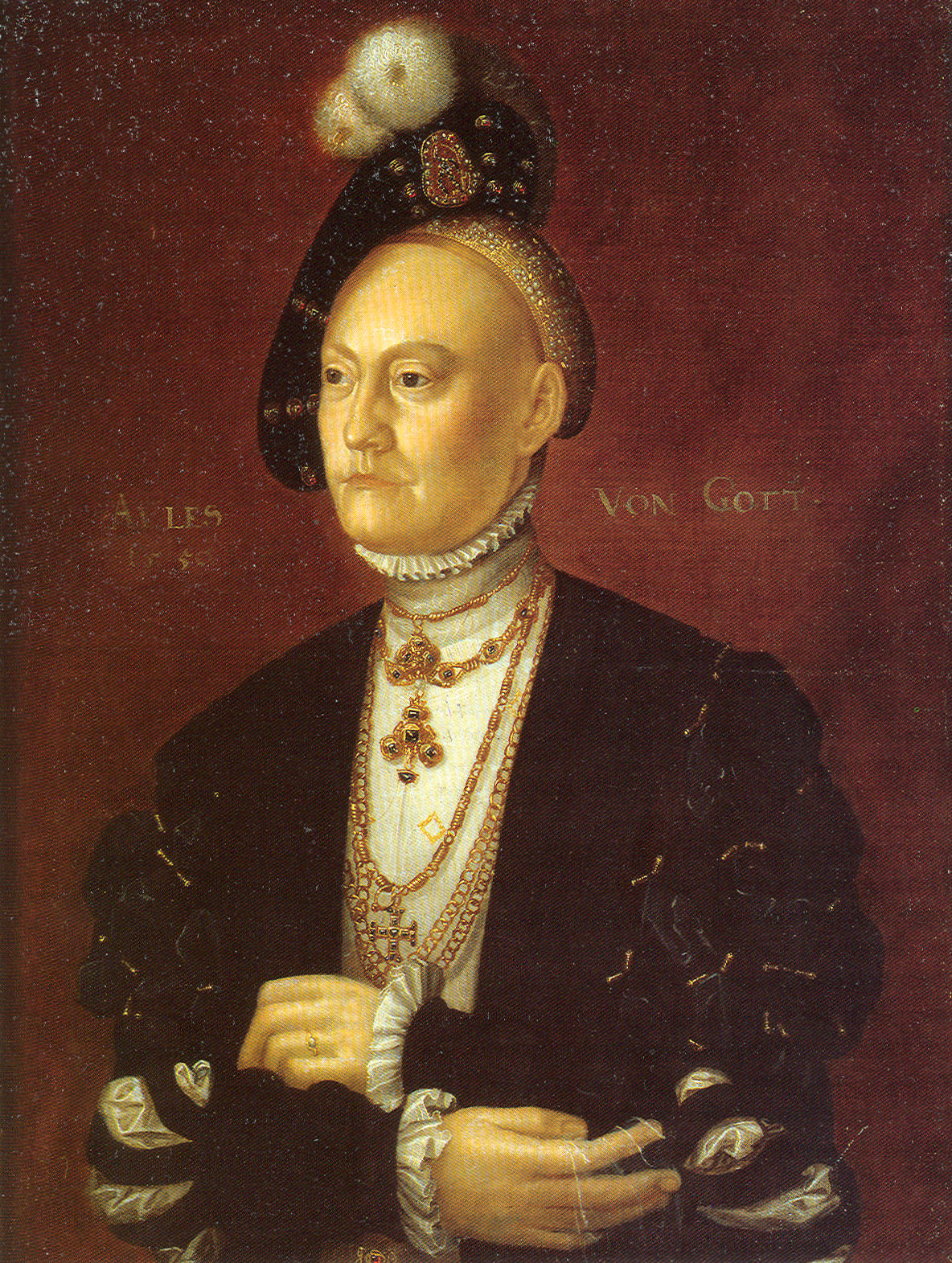
Count Palatine Wolfgang of Zweibrücken (German: Pfalzgraf Wolfgang von Zweibrücken; 26 September 1526 – 11 June 1569) was member of the Wittelsbach family of the Counts Palatine and Duke of Zweibrücken 1532–1559.
He was the only son of Louis II, Count Palatine of Zweibrücken and his wife Elisabeth of Hesse, daughter of William I, Landgrave of Hesse. His father died in 1532, so the regency of Palatinate-Zweibrücken passed to Louis' younger brother Rupert until 1543. In 1557 Wolfgang received the territory of Palatinate-Neuburg in accordance with the Contract of Heidelberg. In 1548 the Holy Roman Emperor Charles V occupied his Protestant territories and reintroduced Catholic practices. This imposition ended in 1552. The Peace of Augsburg of 1555 ended the religious conflict, and in 1557 several ecclesiastical states in Germany weresecularised, a few of which Wolfgang obtained. In 1566 he served as a cavalry officer in the Turkish Wars.

Anna of Hesse (26 October 1529, Kassel – 10 July 1591, Meisenheim) was a princess of Hesse by birth and marriage Countess Palatine of Zweibrücken.
Anna was a daughter of Landgrave Philip I of Hesse (1501–1567) from his marriage to Christine (1505–1549), a daughter of Duke George of Saxony.
Francis I (in Breton Fransez I, in French François I) (Vannes/Gwened, 14 May 1414 – 18 July 1450, Château de l'Hermine/Kastell an Erminig), was Duke of Brittany, Count of Montfort and titular Earl of Richmond, from 1442 to his death. He was son of Duke John VI and Joan of France.

Isabella Stewart (autumn of 1426 – 13 October 1494/5 March 1499) was a Scottish princess and by marriage the Duchess of Brittany. Also known as Isabel Stewart and Isabel of Scotland, she was the second daughter of James I of Scotland and Joan Beaufort and the second wife of Duke Francis I of Brittany.

Albrecht, Graf von Nassau-Weilburg
Padres
Anna von Nassau-Dillenburg
Padres
Matrimonios
Carlos II de Baden-Durlach, en alemán Karl II von Baden-Durlach (Pforzeim, 24 de julio de 1529 - Durlach, 23 de marzo de 1577), fue Margrave de Baden-Durlach desde 1563 hasta su muerte.
Carlos era hijo del Margrave Ernesto I de Baden-Durlach y de su esposa Úrsula de Rosenfeld. Carlos militó en la facción protestante alemana y estuvo entre los principales del Sacro Imperio Romano. En 1555 introdujo los principios de la Reforma en Baden-Durlach, Estado que había heredado al morir su padre en 1553.
En concordancia con su vocación luterana, fue amigo de los teólogos Jacob Andreae y Jacob Heerbrand, quienes lo impulsaron en 1561a participar en las Confesiones de Augsburgo, donde estableció una estrecha alianza con el Príncipe elector Augusto de Sajonia, enviando más tarde tropas a Carlos IX de Francia para sofocar los desórdenes provocados por los hugonotes.
Entre sus hijos, Jorge Federico era de confesión luterana, Ernesto Federico de confesión calvinista y Jacobo era católico.

Friedrich, vildgrave y rhingrave de Salm-Neufville
Friedrich, wild-und rheingraf von Salm-Neufville
Padres
- Philipp Franz, vildgrave y rhingrave de Dhaun und Neufviller * 04.08.1518
- Maria Aegyptiaca von Oettingen-Oettingen * 1520
Franziska von Salm-Badenweiler
Padres
Luis VI del Palatinado (Simmern 4 de julio de 1539 - Heidelberg, 22 de octubre de 1583) fue un príncipe elector del Palatinado-Simmern, rama de la casa de Wittelsbach. Era el hijo primogénito de Federico III del Palatinado y María de Brandeburgo-Kulmbach.
John Frederick I (German: Johann Friedrich I; Torgau, 30 June 1503 – Weimar, 3 March 1554), called John the Magnanimous, was Elector of Saxony and Head of the Protestant Confederation of Germany (the Schmalkaldic League), "Champion of the Reformation".
John Frederick was the eldest son of Elector John by his first wife, Sophie of Mecklenburg-Schwerin. His mother died fourteen days after his birth, on 12 July 1503.

Sibylle of Cleves (German: Sibylle von Jülich-Kleve-Berg) (17 January 1512 – 21 February 1554) was Electress consort ofSaxony.
Born in Düsseldorf,[1] she was the eldest daughter of Johann III of the House of La Marck, Duke of Jülich jure uxoris, Cleves, Bergjure uxoris, Count of Mark, also known as de la Marck and Ravensberg jure uxoris (often referred to as Duke of Cleves) who died in 1538, and his wife Maria, Duchess of Julich-Berg (1491–1543). Her younger siblings were two sisters, Anna (later Queen of England) and Amalia, and a brother, Wilhelm, who became in Duke of Jülich-Cleves-Berg, bearing the promising epithet "The Rich".
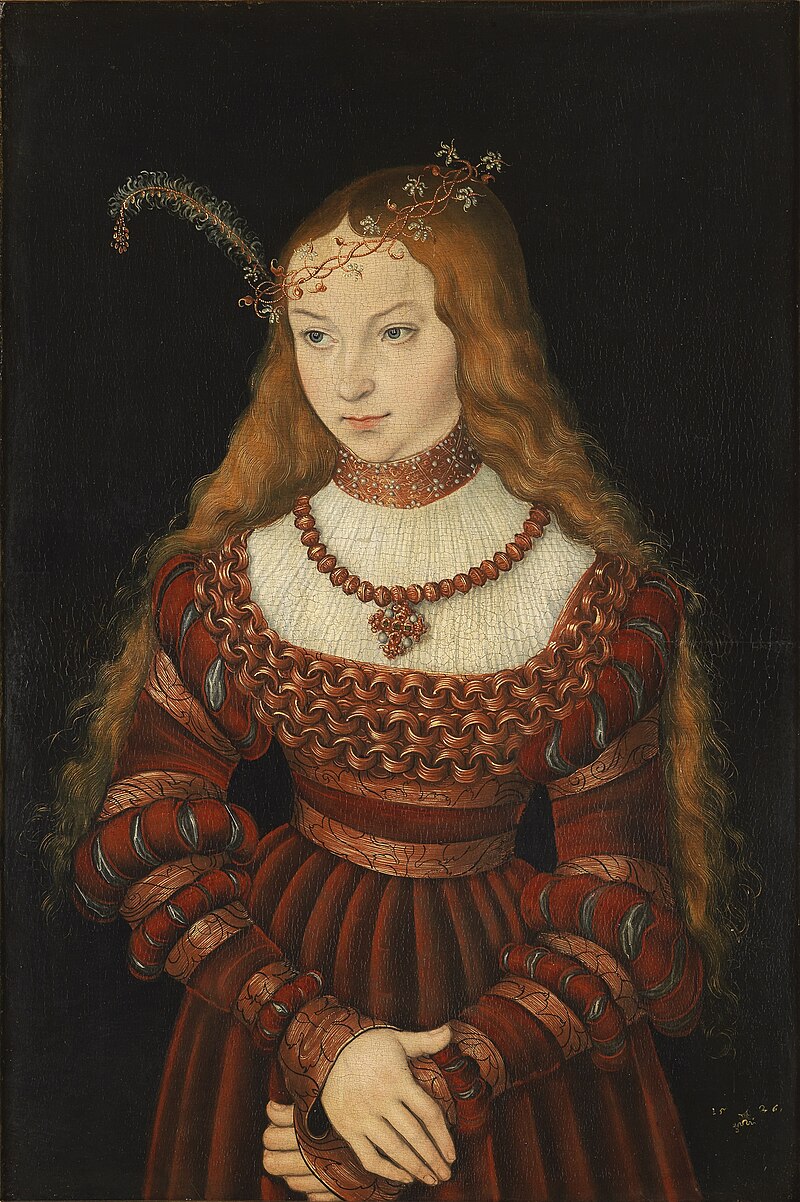
Frederick III of Simmern, the Pious, Elector Palatine of the Rhine (February 14, 1515 – October 26, 1576) was a ruler from the house of Wittelsbach, branch Palatinate-Simmern-Sponheim. He was a son of John II of Simmern and inherited the Palatinate from the childless Elector Otto-Henry, Elector Palatine (Ottheinrich) in 1559. He was a devout convert to Calvinism, and made Calvinism the official religion of his domain. Under his supervision the Heidelberg Catechism was constructed. His support of Calvinism gave the German Reformed movement a foothold within the Holy Roman Empire.
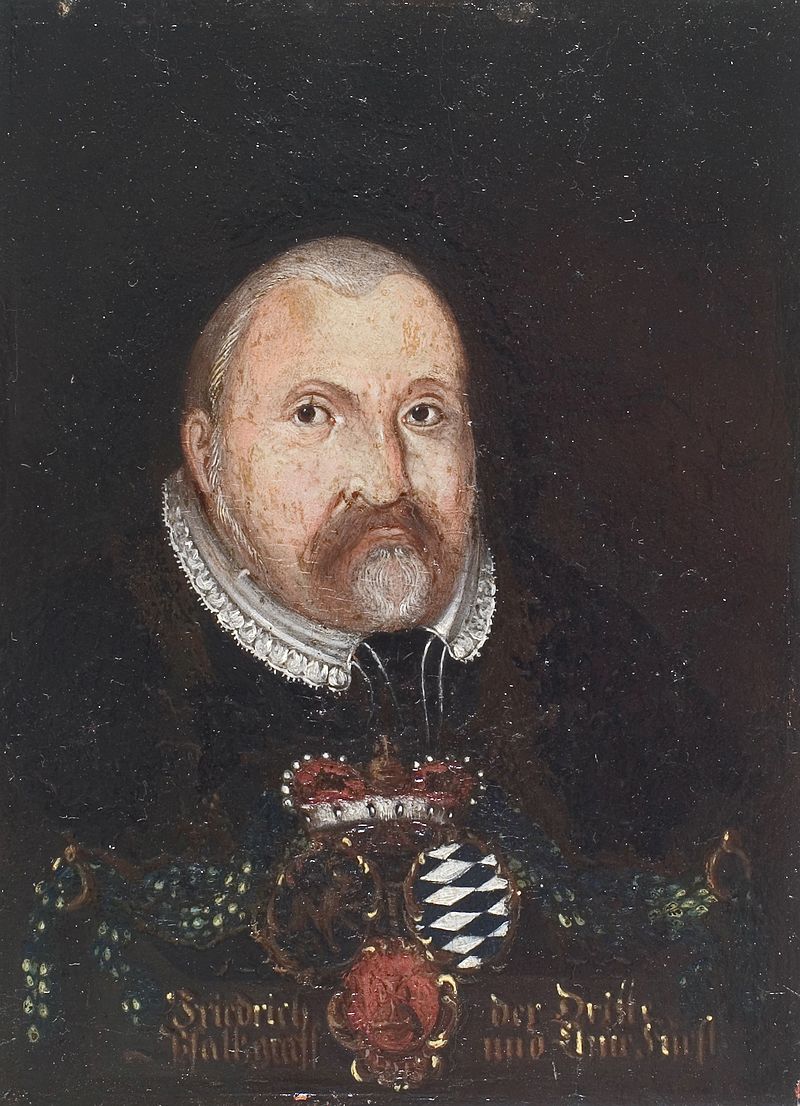
Marie of Brandenburg-Kulmbach (born 14 October 1519 in Ansbach – died 31 October 1567 in Heidelberg) was a Princess ofBrandenburg-Kulmbach and by marriage Electress Palatine.
Marie was the oldest child of the Margrave Casimir of Brandenburg-Kulmbach (1481–1527) from his marriage with Susanna of Bavaria (1502–1543), daughter of Duke Albert IV of Bavaria. After her father's death Marie was raised in the Lutheran faith by her uncle George Frederick.
John V of Anhalt-Zerbst (Dessau, 4 September 1504 – Zerbst, 4 February 1551), was a German prince of the House of Ascaniaand ruler of the principality of Anhalt-Dessau. From 1544, he assumed rule of the re-created principality of Anhalt-Zerbst.
John was the second (but eldest surviving) son of Ernest I, Prince of Anhalt-Dessau, by his wife Margarete, daughter of Henry I, Duke of Münsterberg-Oels, and granddaughter of George of Poděbrady, King of Bohemia.

Margaret of Brandenburg (1511 – after 3 November 1577) was a Princess of Brandenburg by birth and by marrying first a Duchess of Pomerania and later a Princess of Anhalt.
Margaret was the youngest daughter of the Elector Joachim I of Brandenburg (1484–1535) from his marriage to Elisabeth (1485–1555), daughter of King John of Denmark.

hristoph of Württemberg, Duke of Württemberg (12 May 1515 – 28 December 1568) ruled as Duke of Württemberg from 1550 until his death in 1568.
In November 1515, only months after his birth, his mother, Sabina of Bavaria, fled to the court of her parents in Munich. Young Christoph stayed in Stuttgart with his elder sister Anna and his father, Duke Ulrich. When the Swabian League mobilized troops against Ulrich, he brought them to Castle Hohentübingen. In 1519 Württemberg came under Austrian rule after the castle surrendered and Duke Ulrich was banished.
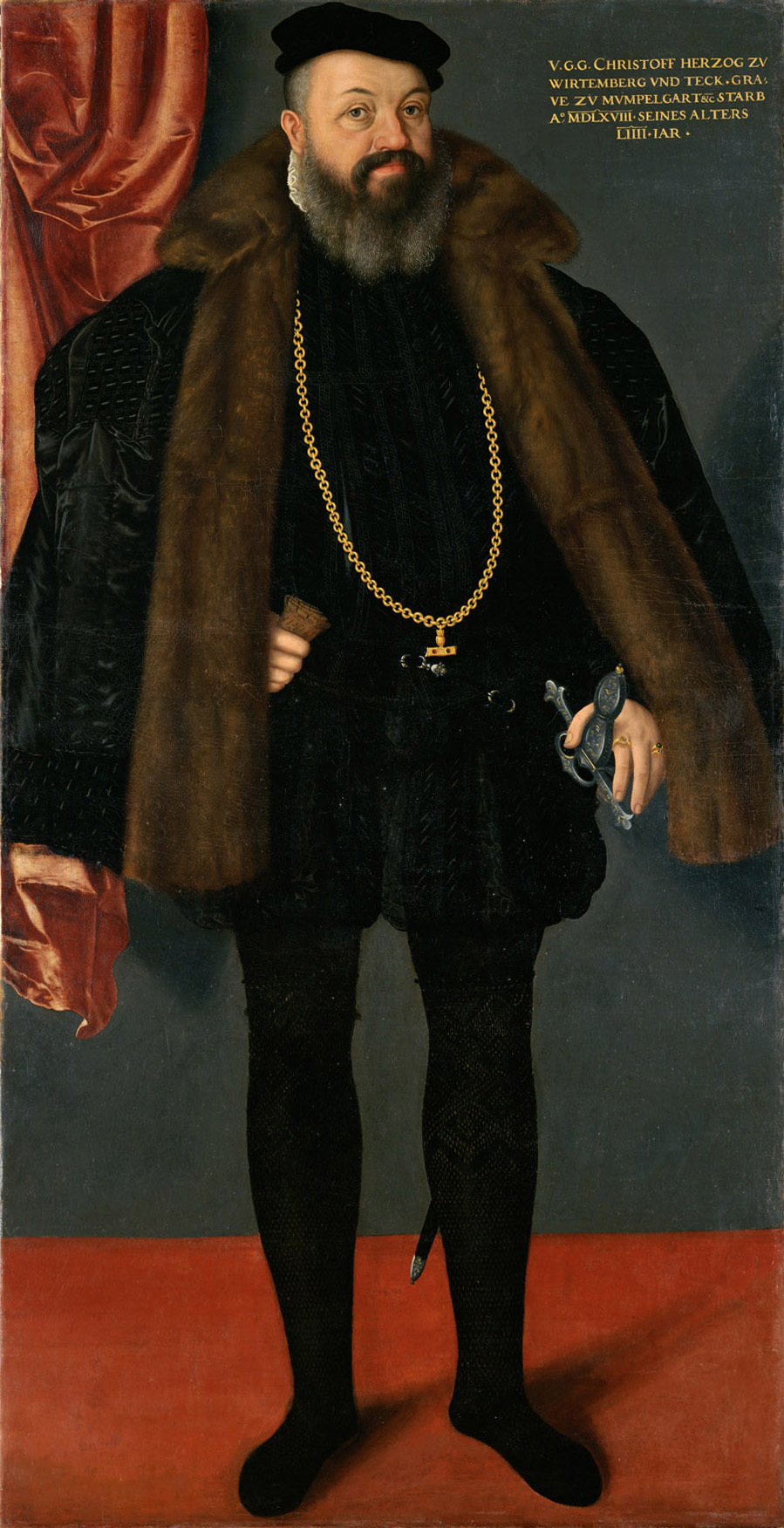
Anna Maria of Brandenburg-Ansbach (28 December 1526 – 20 May 1589) was a German princess of Brandenburg-Ansbach.
Anna Maria was born at Jägerndorf, the eldest daughter of George, Margrave of Brandenburg-Ansbach and his second wifeHedwig of Münsterberg-Oels, daughter of Charles I of Münsterberg-Oels. Anna Maria was brought up as a Lutheran and on 24 February 1544 became the wife of Christoph, Duke of Württemberg. She later acted as guardian to her son Ludwig III, Duke of Württemberg early in his reign. After the death of her husband Christoph she lived more than 20 years in the Nürtingen castle, she died in Nürtingen.
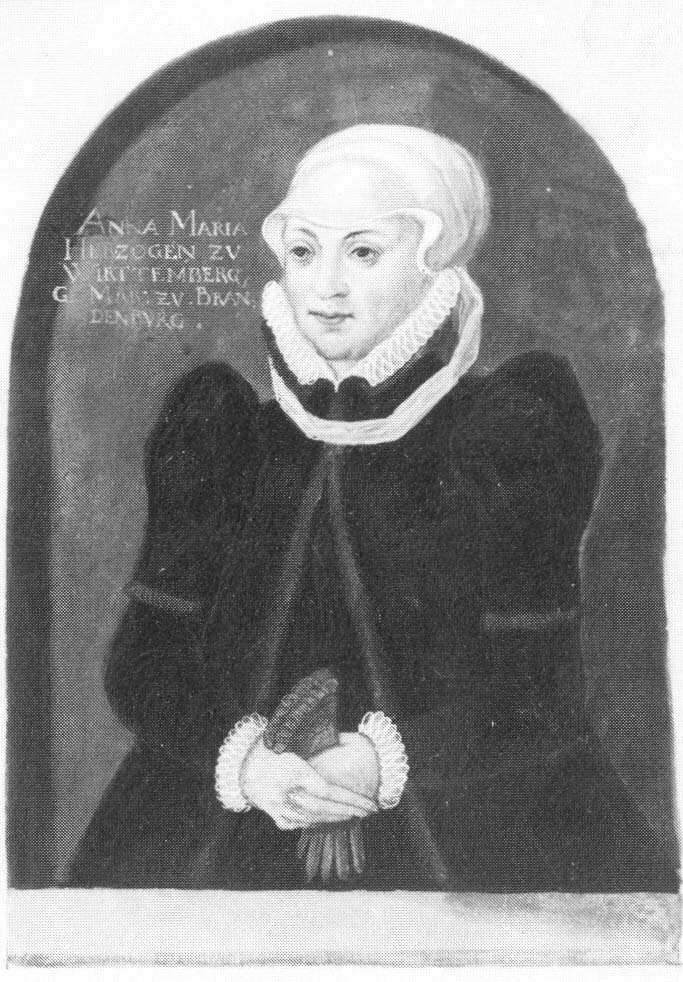
Johann Wilhelm (11 March 1530 – 2 March 1573), was a duke of Saxe-Weimar.
He was the second son of John Frederick I, Elector of Saxony, and Sibylle of Cleves.

Dorothea Susanne of Simmern (15 November 1544, Simmern – 8 April 1592, Weimar) was a princess of the Electorate of the Palatinate and by marriage Duchess of Saxe-Weimar.
Dorothea Susanne was the daughter of elector palatine Frederick III (1515–1576) from his marriage to Marie (1519–1567), daughter of Margrave Casimir of Brandenburg-Kulmbach.
Philipp Ludwig of Neuburg (2 October 1547 – 22 August 1614) was the Duke of Palatinate-Neuburg from 1569 until 1614.
Philipp Ludwig was born in Zweibrücken in 1547 as the eldest son of Wolfgang, Count Palatine of Zweibrücken. After his father's death in 1569, his lands were partitioned between Philipp Ludwig and his four brothers - Philipp Ludwig received the Duchy of Neuburg. He married Anna (1552–1632), daughter of Duke Wilhelm IV "the Rich" of Jülich-Cleves-Berg, in 1574 and used the marriage as the basis of his claim to inherit the duchies in the succession controversy against the Elector of Brandenburg after William IV's only son, John William, died without heirs. In 1613 Philip Louis's eldest son converted to Catholicism and gained the support of Spain and the Catholic League while Brandenburg received the support of the Netherlands.[citation need
Anna of Cleves (1 March 1552, Cleves – 6 October 1632, Höchstädt an der Donau) was a daughter of Duke William V of Jülich-Berg and his wife, Maria of Austria.
Julius of Brunswick-Lüneburg (also known as Julius of Braunschweig; 29 June 1528 – 3 May 1589), Duke of Brunswick-Lüneburg, was prince of Wolfenbüttel from 1568 until his death.
Julius was born and died in Wolfenbüttel. The youngest son of Henry V, Duke of Brunswick-Lüneburg, he was expected to pursue a clerical career. He studied at Leuven University, and was appointed bishop of Minden in 1553, but resigned after only a year. After both of his brothers died in the Battle of Sievershausen of 1553, he became heir to the principality. All plans of his father's to exclude him from the line of succession failed, even though Julius had converted to Protestantism. After his father's death in 1568, Julius instituted a tax reform that improved the rights of farmers in relation to noblemen. He also founded a militia — every head of household was required to own a weapon and participate in military training — and reformed the court system. Julius entered into an agreement with the City of Brunswick in 1569, in which the city recognized his overlordship; however, the conflict between Duchy and City continued nonetheless.

Hedwig of Brandenburg (23 February 1540 in Cölln – 21 October 1602 in Wolfenbüttel) was Margravine of Brandenburg by birth and by marriage Duchess of Brunswick-Wolfenbüttel.
Hedwig was a daughter of the Elector of Brandenburg Joachim II (1505–1571) and his second wife, Hedwig (1513–1573), the daughter of king Sigismund I of Poland.

Augustus (31 July 1526 – 11 February 1586) was Elector of Saxony from 1553 to 1586.
Augustus was born in Freiberg, the youngest child and third (but second surviving) son of Henry IV, Duke of Saxony, and Catherine of Mecklenburg. He consequently belonged to the Albertine branch of the House of Wettin. Brought up as a Lutheran, he received a good education and studied at the university of Leipzig. [1]

Anne of Denmark or Anna (22 November 1532, Haderslev – 1 October 1585, Dresden[1]) was Electress of Saxony and Margravine of Meissen. She was a member of the House of Oldenburg.
Anne was the eldest child of King Christian III of Denmark and his wife Dorothea of Saxe-Lauenburg. Anne learned needlework from her mother as well as herbs, home care, and agriculture. In 1548, she married Augustus I of Saxony ( "Father of August"). She went on to have fifteen children; eleven of them would die young. The couple took up residence at Weissenfels. Before each birth she brought out her shrouds, so they'd be at hand in case of an emergency. She washed and churned herself, doctored her husband and also tried to gain influence on state affairs when court officials did not like the idea of "female domination" at the Saxon court. Elector August was furious, angry that he even changed his religious affiliation to his own form of Lutheranism.

John George of Brandenburg (German: Johann Georg) (11 September 1525 – 8 January 1598) was a Prince-elector of theMargraviate of Brandenburg (1571–1598) and a Duke of Prussia. A member of the House of Hohenzollern, he was the son ofJoachim II Hector, Elector of Brandenburg, and his first wife Magdalena of Saxony.

Sabina of Brandenburg-Ansbach (12 May 1529 – 2 November 1575 ) was a princess of Brandenburg-Ansbach and Electress of Brandenburg by marriage.
Sabina was the daughter of George, Margrave of Brandenburg-Ansbach (1484–1543) from his second marriage to Hedwig of Münsterberg-Oels (1508–1531), daughter of the Duke Charles I of Münsterberg-Oels. The princess was brought up by her stepmother Emilie of Saxony in the Lutheran faith.


No hay comentarios:
Publicar un comentario